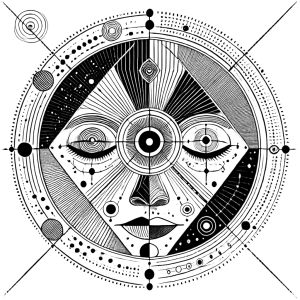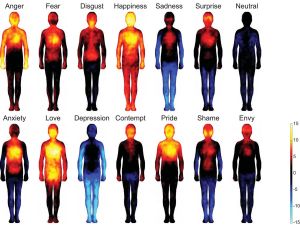InnerMotion – The Guidebook – Embrace Emotions

When you immerse yourself in dance and connect deeply with the music, your emotions naturally become more intense and tangible. This is an integral and essential part of the dance experience. At times, these feelings may be uncomfortable, but instead of avoiding them, it’s important to embrace and remain present with them. Doing so fosters personal growth and enables authentic self-expression.
The Importance of Embracing Emotions
Emotions are integral to your human experience, serving as essential signals that guide you through various situations and help you respond appropriately to your environment. Embracing emotions rather than ignoring them is crucial for several reasons. First and foremost, acknowledging and expressing your emotions allows you to live more authentically. When you suppress your feelings, you create internal conflict, leading to a lack of self-awareness and an incomplete understanding of who you truly are.
Additionally, embracing your emotions can significantly improve your mental health. Unresolved feelings can build up over time, leading to stress, anxiety, and depression. By allowing yourself to feel and process your emotions, you prevent this buildup and maintain a healthier mental state. Understanding your emotions also enables you to develop better strategies for managing them, resulting in healthier relationships and better decision-making. Lastly, sharing your emotions with others fosters deeper connections, enhancing empathy and mutual understanding. In a world where genuine connection is often rare, this emotional honesty can be incredibly powerful.
Positive and Negative Aspects of Emotions
Each emotion, whether pleasant or uncomfortable, has its purpose, offering insights and opportunities for growth. Emotions are neither inherently "good" nor "bad"; rather, they serve as signals that guide you in understanding yourself and your needs. Let’s explore some of these emotions and their dual nature:
- Fear serves a vital role in protecting you from danger and prompting caution. It helps you recognize risks and prepare for challenges. However, if allowed to dominate, fear can paralyze you or cause unnecessary worry, keeping you from exploring opportunities.
- Anger defends your boundaries and motivates you to take action. It can drive necessary change and protect your emotional and physical well-being. Yet, uncontrolled anger can escalate into destructive behavior, damaging relationships and leaving unresolved issues.
- Sadness allows for emotional release and helps you process loss. It deepens your capacity for empathy and connection. However, unaddressed sadness can lead to withdrawal and prolonged depression, isolating you from support and healing.
- Disgust protects you from harmful substances or situations, serving as a natural defense mechanism. But when unchecked, it can lead to prejudice or excessive aversion, distancing you from experiences or people that might otherwise enrich your life.
- Shame reveals the parts of you that need acceptance and healing. It can prompt self-reflection and growth, helping you address areas of your life that feel out of alignment. However, if shame festers, it can lead to feelings of unworthiness and disconnection from others.
- Regret invites you to forgive yourself. It can help you learn from past actions and make better choices in the future. But dwelling too long on regret can trap you in a cycle of guilt and prevent forward movement.
- Disappointment shows you where you hold unspoken expectations. It encourages clarity in your relationships and goals, helping you set realistic standards. On the other hand, excessive disappointment can erode trust and foster pessimism.
- Surprise stimulates curiosity and encourages learning. It keeps you engaged with the world and open to new experiences. On the downside, unexpected surprises can cause shock or disorientation, making it harder to regain balance.
- Happiness uplifts and motivates you, fostering positive interactions and a sense of well-being. It can strengthen relationships and inspire creativity. However, an overemphasis on happiness can create unrealistic expectations, making it harder to accept or process other emotions.
- Joy invigorates your spirit and provides moments of pure connection to the present. It enhances creativity and builds resilience. But like happiness, joy can become fleeting if tied solely to external achievements or validation.
- Gratitude shifts your focus to the abundance in your life. It fosters a positive mindset, strengthens relationships, and increases overall satisfaction. Yet, when forced or insincere, it can suppress other valid emotions that need to be expressed.
- Love connects you deeply with others, enhancing your sense of belonging and fulfillment. It motivates acts of kindness and strengthens bonds. However, love can also make you vulnerable to heartbreak or lead to unhealthy attachments if not balanced with self-respect.
By understanding the dual nature of these emotions, you can embrace them as valuable guides rather than obstacles. This awareness allows you to navigate your emotional landscape with greater wisdom and authenticity, enriching your dance and life.
Effects of Emotions in Dancing
Your emotions profoundly affect your body, posture, and dance moves. Each emotion uniquely shapes how you hold yourself and how you move, offering opportunities for deeper connection and authentic expression.
- Fear often results in tense muscles, hunched shoulders, and wide eyes. In dance, it can translate to quick, sharp movements and retreating or protective gestures, reflecting a sense of caution or urgency.
- Anger typically manifests as clenched fists, tense muscles, and a forward-leaning stance. In dance, this emotion may be expressed through strong, forceful movements and aggressive gestures, embodying a sense of power and defiance.
- Sadness often leads to slumped shoulders, a lowered head, and slow, deliberate movements. In a dance context, sadness might be conveyed through gentle, flowing movements and expressions of longing or loss, creating a poignant and emotional connection.
- Disgust is seen in a wrinkled nose, a turned-away head, and closed-off body language. This emotion might appear in dance as jerky, rejecting movements and pushing away or wiping gestures, reflecting a sense of aversion.
- Surprise often causes raised eyebrows, an open mouth, and sudden, unpredictable movements. In dance, surprise can be expressed through quick, exaggerated gestures and unexpected changes in direction, conveying curiosity or astonishment.
- Shame may result in a lowered gaze, hunched shoulders, or protective body language, reflecting an urge to hide or withdraw. In dance, it can translate into small, hesitant movements or a retreating stance, signaling vulnerability.
- Regret might manifest as repetitive movements, as if replaying a moment, or gestures that seem to pull inward, symbolizing introspection. It invites a sense of forgiveness and release through slow, reflective dance expressions.
- Disappointment often brings a subtle deflation in posture or gestures that fall short of full extension. In dance, this can be shown through incomplete movements or gestures of letting go, symbolizing unmet expectations.
- Happiness results in relaxed muscles, an upright posture, and a smiling face. When expressing happiness, you might display bouncy, energetic movements and open, expansive gestures, radiating joy and positivity through your dance.
- Joy brings an undeniable lightness to movement, with spontaneous, free-flowing gestures and a sense of playfulness. In dance, joy can be expressed through energetic leaps, spins, and an exuberant connection to the rhythm.
- Gratitude can be expressed through open, expansive gestures and an uplifted posture, symbolizing appreciation and connection. In dance, it might take the form of reaching outward or upward, embodying a sense of thankfulness and abundance.
- Love often manifests in soft, flowing movements, a relaxed posture, and gestures that reach outward or draw close to the heart. In dance, love can be expressed through tender, connected movements that convey warmth and vulnerability.
By understanding and embracing these emotions, you can connect more deeply with the music and your inner experiences, transforming your dance into a profound and authentic expression. This awareness allows you to fully embody the emotional spectrum, enriching the quality of your dance and supporting personal growth. Through the power of music and movement, you can explore and express the full range of human emotions, leading to a more vibrant and fulfilling life.
How Music Initiates Emotions
Music holds a profound ability to connect with you on a deep, non-verbal level, often initiating a wide range of emotions. The rhythm and tempo of a piece of music play a significant role in this process. Fast tempos can energize and excite you, while slow tempos can calm and soothe your mind. The rhythm can even mirror your heartbeat, influencing your physical state and emotional responses. Similarly, different melodies and harmonies can evoke various feelings. Minor keys often evoke sadness or reflection, while major keys tend to inspire happiness and upliftment.
The lyrics of a song can also resonate deeply with your personal experiences, triggering specific emotions and memories. When you hear words that echo your own stories, you feel seen and understood, and your emotions are validated. Additionally, changes in volume and dynamics within a piece of music can heighten your emotional responses, creating feelings of anticipation, surprise, or relief. These elements combined make music a powerful tool for initiating and exploring your emotions.

Exercise
- Acknowledge Your Emotions: Start by acknowledging whatever emotion you are experiencing. Verbalize it if needed - say to yourself, "I am feeling sad," or "I am feeling anxious." Naming the emotion helps you to recognize and accept it without judgment.
- Focus on the Feeling in Your Body: After naming the emotion, shift your focus to how it manifests in your body. Identify where you feel it - maybe it’s a tightness in your chest, butterflies in your stomach, or tension in your shoulders. Notice the intensity and quality of the sensation.
- Integrate the Emotion into Your Dance: Incorporate the emotion into your movements. Let your dance be an expression of what you are feeling. If you are sad, your movements might be slower and more deliberate. If you are frustrated, you might move more vigorously. Use the dance to channel and process the emotion.
- Stay with the Emotion: Resist the urge to think about the emotion or push it away. Stay with it, allowing yourself to fully experience and express it through your body. This process can be uncomfortable, but it is essential for emotional release.
- Trust the Process: Understand that the goal is not to force yourself to feel happy or to recreate past emotions associated with certain songs you really like. Trust that by fully embracing your current emotions, joy and happiness will naturally emerge in their purest form and have a lasting impact on your well-being.
- Be Patient: Sometimes, it takes a long time for unpleasant feelings to pass. Be patient with yourself and trust that this process is necessary for emotional growth. If the emotion persists throughout the dance session, acknowledge it and understand that it’s part of a larger process.
- Seek Support if Needed: If certain emotions feel overwhelming or persist for a long time, it may indicate something significant in your life that needs attention. Consider talking to a family member, friend, or psychotherapist to help process these emotions. Seeking support is a sign of strength, and professional help can provide valuable tools for managing intense feelings. Remember, everyone needs help sometimes, and reaching out can make a significant difference in your emotional well-being.
By embracing your emotions fully during dance, you allow for a deeper, more authentic experience. This practice not only enhances your dance but also contributes to your overall emotional health, leading to a more balanced and fulfilling life.